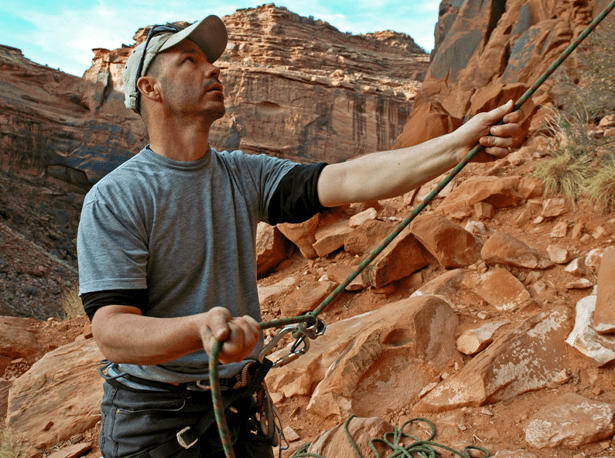What is Belaying in Rock Climbing? Everything You Need to Know
While many people believe that having strong fingers and good footwork is the key to being a good climber, the fact is that being a real rock climber requires more than simply moving effectively on the rock. To be a skilled climber, one must also be able to belay.
Because belaying is a talent, it takes time and effort to become an expert. Although many individuals begin climbing and attend a learn-to-belay lesson in a gym or outside, many people – both newbies and seasoned vets – make serious mistakes when maintaining the rope.
Have you been climbing a few times and now want to take it to the next level? If that’s the case, you won’t be able to achieve it without the right belaying method. Both inside and outside of the gym, belaying is an essential aspect of top-rope climbing. Continue reading to know more about belaying.

What Is Belaying In Rock Climbing?
If you’re new to climbing, belaying may be unfamiliar territory for you. That’s okay! While “belaying” can apply to a variety of approaches, in general, belaying is the act of putting tension on a climbing rope to counterbalance the climber as they fall. As the climber ascends, the person holding the rope, known as the belayer, pulls the rope through a belay apparatus. As a result, if the climber falls, they don’t fall very far.
Must note the safety points being a pregnant rock climber, here!
Many methods of free climbing entail wearing a harness and using ropes to climb a rock, crag, or wall. The rope will be secured to your harness by a knot, to the wall via a bolted anchor or fixed gear, and to the harness of your climbing partner via their belay device, unlike in the past when the rope was just knotted around your waist.
A belay device is a small pulley made of aluminum or alloy that allows your companion to impart swift, abrupt strain to the rope by closing it off, limiting how far you fall. Your companion doesn’t have to carry the majority of the weight since the belay device does. They stay on their feet as you dangle in mid-air for a few seconds before returning to the wall and continuing to climb.
Different Types Of Belay Devices
Automatic and manually controlled belay devices are the two primary types of belay equipment. A tiny belay device is attached to the belayer’s harness and allows them to manage the rope when belaying for top rope or lead climbing. There are many different types of manually operated belay devices, but the most popular are tubular, aided braking, and figure 8 belay systems. When it comes to belaying devices, there are three main categories to consider:
1. Tubular
These are quite ubiquitous and may be used for any type of climbing. The rope is folded and forced through the device before being fastened to the belayer or directly to the anchor using a locking carabiner. The friction created by the bent rope’s contact with the belay device causes the rope to slow down and halt, protecting the climber. To increase friction, several tubular devices incorporate ridges or “teeth.”
2. Assisted braking
Assisted-braking devices accomplish exactly what they seem like they do: they help the belayer catch a fall or keep a hanging climber in place. While the methods of action alter, the essential principle remains the same. The major advantage of an assisted braking gear is that it can aid stop a climber from falling, especially if the climber and belayer are of different weights.
3. Figure 8
Figure 8 devices are most commonly employed for rappelling, although they may also be used to belay a leader or a top-rope climber. They are shaped like the number eight, with one bigger and one smaller hole. Figure 8s are commonly employed in search and rescue, cave exploration, and rappelling.
Belaying A Top-Rope Climber
Many of the same belay methods are used in top-roping as in lead climbing. Top-rope belaying, on the other hand, mostly entails hauling in rope slack put off by the climber. The PBUS (pull, brake, under, slide) approach is used to address the demands of top-rope belaying.
- Pulling your guiding hand down while simultaneously lifting the clutched brake rope out and up absorbs rope slack.
- As your guiding hand approaches the belay device, flip the brake rope down to secure the rope in place.
- Place your guide hand beneath your brake hand as you move your guide hand onto the brake rope. While the other hand slips, you may utilize this guiding hand as your new brake hand.
- Loosen your original brake hand’s grip and move it upward until it is six inches below the belay device. Now take a tight grip on the rope.
How Do You Practice Belaying?
Belaying begins with tying onto the same climbing rope as ascending. The climber should tie a figure-eight knot to their harness, and the belayer should tie a stopper knot.
- Perform a safety check on your lead climber’s equipment before they leave.
- Maintain vigilance until they have connected their quickdraw to their first anchor.
- Maintain appropriate posture, utilize your dominant hand as your brake hand, and have a firm grasp on the rope at all times.
- Check the slack in the rope. If your lead climber falls, the rope may force your body forward into the face of the wall or upward against it. Clear the gap between you and the wall to prepare for a fall.
- At all times along the ascent, communicate clearly. Because your lead climber will be unable to see you, it is your responsibility to keep an eye on them and communicate with them as needed.
What Is The Difference Between Rappelling And Belaying?
A rappel is when you lower yourself down the rope, but a belay is when you catch someone else who is tied to the same rope as you. So, can you rappel while using a belay device? Yes. Almost any belaying equipment will allow you to rappel. The rappel method will be quite similar to the belay technique.
Can I Belay Someone Heavier Than Me?
Every climber is unique. It makes no difference if the belayer is heavier. When offering a gentle catch, it makes a significant difference. Light belayers do not have to jump since they can be dragged up. When they outweigh their climber, heavy belayers must make an extra effort to jump.
The quick answer is yes, you can certainly belay someone heavier than your top rope. Belaying a larger, heavier climber may be just as pleasurable and risky as belaying any other climbing partner. You may avoid injuries by constantly using correct belaying methods and remaining alert.






